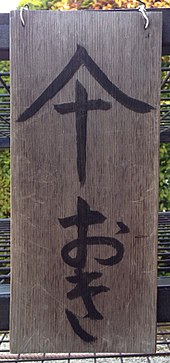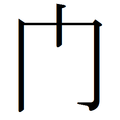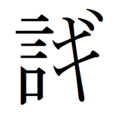Ryakuji


 |
| Japanese writing |
|---|
| Components |
| Uses |
| Transliteration |
In Japanese language, Ryakuji (Japanese:
Status[edit]
Ryakuji are not covered in the Kanji Kentei, nor are they officially recognized (most ryakuji are not present in Unicode). However, some abbreviated forms of hyōgaiji (
Some simplifications are commonly used as special Japanese typographic symbols. These include:
- 々, the kanji iteration mark, from 仝, a variant of
同 ; - 〻, the vertical form, from
二 ; - the hiragana and katakana iteration marks, ゝ and ヽ, generic strokes;
- 〆, shime, simplification of
占 (as占 め しめ shime) as cursive form of top component ト, used for various kanji read as しめ shime, primarily締 め, also閉 め,絞 め,搾 め, and original占 め; - ヶ, small ke, simplification of 箇 (also used for
個 ), though with other uses.
Of these, only 〆 for
Replacements of complex characters by simpler standard characters (whether related or not) is instead a different phenomenon, kakikae. For example, in writing
Compare this to simplified Chinese.
Use[edit]
Ryakuji are primarily used in individual memos, notes and other such forms of handwriting. Their use has declined in recent years, possibly due to the emergence of computer technology and advanced input methods that allow equally fast input of both simple and complex characters. Despite this, the ryakuji for
Abbreviations for multiple-character words or phrases[edit]
In all cases discussed in the other sections of this article, individual characters are simplified, but separate characters are not merged. There are rare cases of single-character abbreviations for multiple-character words or phrases, such as 圕 for
Examples[edit]

Notes[edit]
Of these, several are commonly seen in signs:
- 1 and 2. (
第 ,門 – These are perhaps the most commonly used Ryakuji. 1 (dai, ordinal prefix) is present in Unicode as U+3427 (㐧), but is not supported by the MS Gothic or Mincho family of typefaces, or Arial Unicode MS. According to the original Japanese article, 1 has been seen on roadsigns on the Keihin #3 Road (㐧三京浜 道路 , Dai-San Keihin Dōro). 2 is present in Unicode as U+95E8; it is unified with the closely related Simplified Chinese abbreviation 门 (both originated from cursive script forms). The Japanese form may be explicitly induced with the sequence U+95E8 U+E0100. - 3. (
点 ) – An abbreviation of the bottom four dots in the character点 is present in Unicode as 奌 U+594C, but is not supported by the MS Gothic or MS Mincho typefaces. It does appear in Arial Unicode, Sim Sun, Sim Hei, MingLiU, KaiU and New Gulim typefaces. Another simplification of this sort can be seen for the bottom four dots of魚 (present in Unicode as 𩵋 U+29D4B). The bottom of the characters熱 and馬 , however, are simplified instead using a horizontal line, as in the Simplified Chinese characters 马 and 鱼. - 4. (
職 ) (variant 1 is present in Unicode as U+803A; variant 2 is U+2B7C9) – Also used often, but somehow not applied to the related characters織 and 識. - 5. (曜)
 (⿰
(⿰日 玉 , from 曜 = ⿰日 翟) (present in Unicode as 𫞂 U+2B782) – Also often written as 旺 (originally a different character), but the dot (as in玉 ) is used to distinguish. Common abbreviation in stores for days of week. The phonetic 翟 is generally not abbreviated to玉 in other character such as 濯, 擢,櫂 ,躍 , 燿, or 耀. - 6. (
前 ) – Grass script form (1 and 2 also originated from grass script forms) - 7. (
個 ) (present in Unicode as 㐰 U+3430) – Abbreviated by removing the contents of the kunigamae (固 ) component. There is also the 囗 (U+56D7) abbreviation for国 . - 8 and 10. (
選 機 , not present in Unicode) – A portion at the top consisting of two or more consecutive characters is changed to a ⺍ shape. This can be seen in the Shinjitai simplifications榮 →栄 ,單 →単 ,嚴 →厳 ,巢 →巣 ,學 →学 . The竹 top radical has also been used (although rarely). A colloquial simplification for機 exists (not present in Unicode) in which the right portion is replaced by katakana キ (ki) to indicate the on reading. - 9. (濾) (present in Unicode as 沪 U+6CAA) – Not as common a character, but a major ryakuji in scientific circles, as it is used in such words as
濾過 (roka, percolation). This character has also been seen in print. The component盧 , pronounced RO just like慮 , is commonly simplified to戸 as well such as in蘆 →芦 and the Shinjitai simplification爐 →炉 . - 11.
闘 to 閗 (⿰門 斗 ) or simply斗 (in Unicode at U+9597). The complicated character闘 (tō) is replaced by a simpler character of the same On reading,斗 . This is formally known as kakikae, if one standard character is replaced by another standard character of the same reading, though hybrids such as 閗 (門 斗 ) are ryakuji. Another example of kakikae is年齢 43歳 →年令 43才 (nenrei 43 sai "age 43 years"), and simplifications of this method have also been seen in print. - 12. (
品 ,器 ) (present in Unicode as 𠯮 U+20BEE) – Also commonly seen. The bottom 吅 portion of品 is merged. Examples have also been seen in characters such as靈 (the Kyūjitai of霊 ) in which the 𠱠 portion has been merged. - 13.
魔 ,摩 (not present in Unicode) – A colloquial simplification in which katakana マ (ma) is used to indicate the on reading of both characters (ma). The simplification for魔 is seen in manga, and the simplification for摩 is commonly seen when writing place names such as Tama, Tokyo (多摩 市 ).
Further examples[edit]
Omitting components is a general principle, and the resulting character is often not a standard character, as in
If the resulting character is a standard character with the same reading (common if keeping the phonetic), this is properly kakikae instead, but if it is simply a graphic simplification (with a different reading) or the resulting character is not standard, this is ryakuji. One of the most common examples is
齢 →令 in年齢 →年令 歴 →厂 in歴史 →厂史経 →圣 in経済 →圣済
In some cases, a component has been simplified when part of other characters, but has not been simplified in isolation, or has been simplified in some characters but not others. In that case, simplifying it in isolation can be used as common ryakuji. For example,
More unusual examples come from calligraphic abbreviations, or more formally from printed forms of calligraphic forms: a standard character is first written in a calligraphic (
Derived characters[edit]
Derived characters accordingly also have derived ryakuji, as in these characters derived from
-
門 -
間 -
開
Similarly, the
Phonetic simplifications[edit]
Some ryakuji are simplified phono-semantic characters, retaining a radical as semantic and replacing the rest of the character with a katakana phonetic for the on reading, e.g.,
Another example is
This may also be done using Latin characters; for example, the character
The character
-
木 + キ
See also[edit]
- 〆, shime, simplification of
占 (as占 め しめ shime) - ヶ, small ke, simplification of 箇
- Kana ligature
- Shinjitai
- Simplified Chinese character
- Variant Chinese character
- Yakja, Korean simplifications
References[edit]
- ^ "
常用漢字 表 の字体 ・字形 に関 する指針 (報告 )について" (PDF). Agency for Cultural Affairs. p. 73. Retrieved 6 December 2019.
This article needs additional citations for verification. (March 2011) |
- Spahn and Hadamitzky, The Kanji Dictionary, ISBN 978-0-8048-2058-5
External links[edit]
- More examples of Ryakuji
- Even more examples of Ryakuji Archived 2014-09-07 at the Wayback Machine










